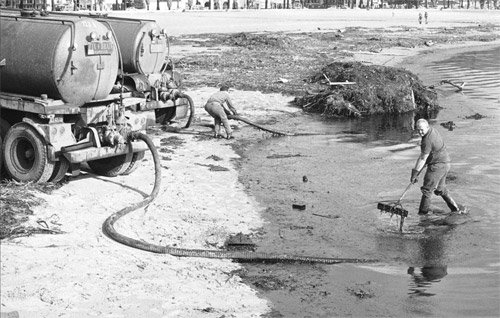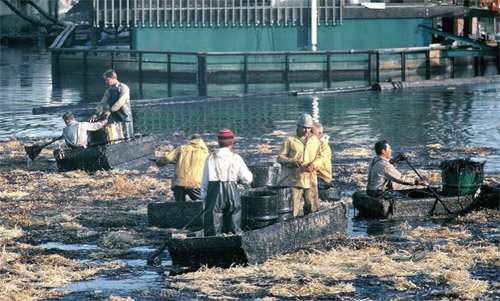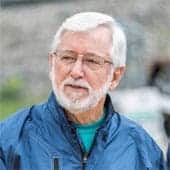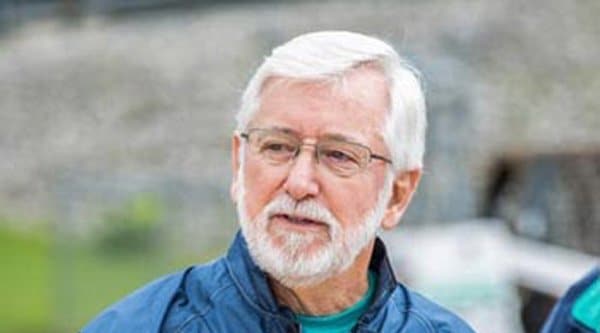Minibytes by Al Allen


In 1969, just a few days after the blowout on Platform A in the Santa Barbara Channel, California, I stood on Sterns Wharf, watching crude oil slide into the Santa Barbara Marina. It had been a week since the spill started, and yet the best efforts that seemed possible at that time included a floating string of telephone poles to serve as containment boom and vacuum trucks positioned along the shoreline to suck up oil from the water surface through 4-inch open-ended hoses (photo #1). Shortly after that day, highly “sophisticated” vessel-mounted recovery techniques were deployed (photo #2). Little did I know that the inefficiencies of those response efforts would capture my imagination and set me on a 50-year-long mission to find better ways to contain and remove spilled oil.
Prior to that blowout off Santa Barbara, I had been diving on and measuring flow rates of natural oil seeps in the same region. And so, just for kicks, a very good friend (along with his own small aircraft) and I monitored and photographed the blowout over several weeks. Using the same techniques we had developed to measure natural oil seep flow rates, I had soon come up with estimates of the blowout flowrate. When the oil industry and government agencies learned of these flights, and that my calculations revealed possible blowout release rates ten times greater than their own, I was soon sucked into a media blitz, threats, testimony before a U.S. Senate Subcommittee in Washington, D.C., and years of litigation. When the case was finally over, my estimates proven correct, and the financial settlements reached, I encountered an unexpected strong encouragement to be available as an Oil Spill Specialist for future oil spills. While reluctant at first, I gradually accepted the challenge. I knew, however, that I’d better be much more than just a spill volume estimator; I’d better get serious and focus on ways to improve the “Efficiency of Response”! A whole new career soon evolved. I am hoping that the sharing of that “journey” through these minibytes will be of interest and hopefully of value for you.
In my previous blogs the importance of oil encounter rate was discussed along with an equation for calculating a skimming system’s oil volume encounter rate. Limitations affecting that rate included the physical characteristics of the skimming system (swath and speed) and the nature and thickness of the oil being accessed. Now it’s one thing to be able to access oil quickly, but it’s another (as described above) to do it efficiently! Last month I discussed how throughput efficiency is the % of oil encountered that is actually skimmed and taken onboard. Depending on the type of skimmer involved, the skills of those operating the skimmer, wind and sea conditions, etc., as much as 50% of the oil encountered could easily slip around, through or under the skimming system. In recent years manufacturers of advancing skimmers have come up with a number of clever systems, including rotating drums and discs with highly oleophilic (or oil-liking) surfaces. Such skimmers have been positioned alongside or within vessels with deflection booms so that throughput efficiencies of 75% to 85% can be achieved. These advancements have also led to recovery efficiencies (the % of oil in the oil/water mix taken onboard) that can reach values of 85% to 90% under favorable operating conditions.
In the near future, I will talk about the advancements that have also been realized involving the controlled burning of oil on water, and the treatment of oil with chemical dispersants. During burning operations, fire-resistant booms are towed behind two boats in a U-configuration to collect 100’s to even 1,000’s of barrels of oil, after which hand-held or aerially deployed igniters can be dropped into the oil to eliminate most of the oil within an hour or less. Dispersants can be deployed by boat or from aircraft at much higher speeds than vessels involved with skimming or burning. The dispersants modify the oil’s physical and chemical properties, allow the oil to break into extremely small droplets, remove the oil from the surface, and accelerate the dispersion and natural degradation of the oil within the water column. The amount of dispersant used is often a very small fraction of the amount of oil that can be dispersed (as little as 5%, or even 1% or less with the latest chemicals).
The efficiencies with which oil can be burned quickly at the water surface, or eliminated with dispersants (typically as high 75% to 95%), often compete with and even surpass the efficiencies discussed above involving the mechanical containment and recovery of oil with skimmers. While such efficiencies are achievable under favorable conditions, there are many operational, environmental and sociopolitical factors that can seriously impact the feasibility and the desirability of implementing the use of burning and dispersants.
Vast amounts of research, seminars, workshops, training exercises, laboratory studies and field trials have been conducted over several decades dealing with the feasibility, efficiency, costs, safety issues, environmental impacts, and overall tradeoffs of these response options. Clearly, those issues are far too complex and controversial to address adequately in monthly mini-blogs. However, I do hope that I can bring about a modest appreciation and basic level of understanding for the science (and even the art) of oil spill prevention and response, and why it is so important to keep our oceans, lakes, rivers, streams and land as clean as possible. I will try to balance these issues with personal stories, fond memories, stupid mistakes, near-death experiences, and lessons learned along my own oily path.

Alan A. Allen has over five decades of experience as a technical advisor and field supervisor involving hundreds of oil spills around the world. Al is recognized as a leading consultant and trainer involving oil spill surveillance and spotting techniques, the application of chemical dispersants, and the containment, recovery and/or combustion of spilled oil under arctic and sub-arctic conditions.
Copyright© 2018, Al Allen. Unauthorized use and/or duplication of this material without express and written permission from this blog’s author is prohibited.

